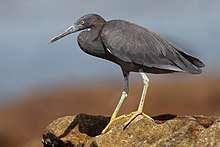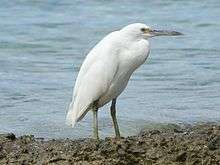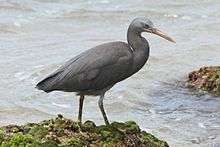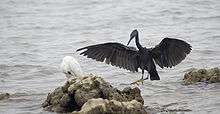Pacific reef heron
The Pacific reef heron (Egretta sacra), also known as the eastern reef heron or eastern reef egret, is a species of heron found throughout southern Asia and Oceania.[2]
| Pacific reef heron | |
|---|---|
 | |
| Dark morph | |
 | |
| Light morph | |
| Scientific classification | |
| Kingdom: | Animalia |
| Phylum: | Chordata |
| Class: | Aves |
| Order: | Pelecaniformes |
| Family: | Ardeidae |
| Genus: | Egretta |
| Species: | E. sacra |
| Binomial name | |
| Egretta sacra (Gmelin, 1789) | |
Taxonomy and systematics
The Pacific reef heron is referred to by a variety of names by the indigenous peoples of the Pacific region. In New Zealand, multiple names have been given, including kākatai, matuku moana and matuku tai.[3] It is known as belō in Fiji, matu'u in the Samoan Islands, and motuku in Niue, Tonga, and Wallis Island.[4]
Description
Pacific reef herons are medium-sized herons, reaching 57 to 66 cm in length. They have a wingspan of between 90 and 110 cm and reach an average weight of 400 grams.
The species displays an unusual, non-sexual dimorphism, with some members having entirely white plumage ('light' morph) and others (the larger portion) being charcoal-grey ('dark' morph). The reason for the colour variation or "morph", is unknown, though it is most commonly thought to be related to camouflage. The plumage of immature herons tends to be browner and duller in colour.[2]
Pacific reef herons have very short, yellow legs, and the grey variety's throats and chins are marked by a narrow, white stripe. They have brown beaks, gold-yellow coloured eyes and the surrounding areas of their faces are normally of a greenish to yellow cast.
Distribution and habitat
The Pacific reef heron is widely distributed across southern Asia and Oceania. In Australia, Pacific reef herons inhabits most of the coastline, and offshore islands including the Torres Strait Islands.[5]
Pacific reef herons are widespread across Micronesia, with breeding records in Guam, the Marshall Islands, Northern Mariana Islands, and Palau, among various other islands.[6] The species also breeds throughout western Polynesia, including in Fiji[4], French Polynesia[7], and Tonga[8] – though it does not breed in Niue.[4] Surveys of the Fijian island of Rotuma, conducted in 1991 and 2018, suggest that the Pacific reef heron has recently colonized the island.[9]
New Zealand is considered to be the southern limit of the Pacific reef heron's distribution.[10] Despite being relatively uncommon, the herons are found throughout the country, though are most common in Northland.[11]
Behaviour and ecology
Breeding
The species lay clutches of eggs year-round in colonies in the jungle, between palms and mangroves or in cavities of old buildings. Two to three paled greenish-blue eggs are laid in nests constructed from branches and blossoms. Males and females share brooding tasks. They normally have a 28-day brood period. After chicks are hatched, parents provide approximately 5 weeks of support.
Food and feeding
Their food sources are made up predominantly of varieties of ocean-based fish, crustaceans and molluscs.
Conservation status
In New Zealand, the Pacific reef heron has the conservation status of "Nationally endangered". It has been classified as "Regionally Critical" in the Wellington region.[12]
Gallery
 Dark morph
Dark morph
 Juvenile dark morph, Coral Bay, Western Australia
Juvenile dark morph, Coral Bay, Western Australia
References
- BirdLife International (2012). "Egretta sacra". IUCN Red List of Threatened Species. 2012. Retrieved 26 November 2013.CS1 maint: ref=harv (link)
- Edgar, A. T. (1978). "The reef heron (Egretta sacra) in New Zealand" (PDF). Notornis. 25 (1): 25–58. Retrieved 30 January 2020.
- Ryan, P. M. (2012). The Raupo Dictionary of Modern Māori. Raupō. ISBN 9780143567899.
- Watling, Dick (2001). A guide to the birds of Fiji & Western Polynesia. Suva, Fiji: Environmental Consultants Fiji. p. 99.
- Lavery, Tyrone H.; Watson, Justin J.; Leung, Luke K.-P. (2012). "Terrestrial vertebrate richness of the inhabited Torres Strait Islands, Australia". Australian Journal of Zoology. 60: 180–191. Retrieved 30 January 2020.
- Wiles, Gary J. (2005). "A checklist of the birds and mammals of Micronesia". Micronesia. 38 (1): 149–189.
- Beaune, David; Ghestemme, Thomas; Raust, Philippe; Blanvillain, Caroline (2018). "Herons of French Polynesia: threats, status and conservation" (PDF). Journal of Heron Biology and Conservation. 3. Retrieved 30 January 2020.
- Steadman, David W. (1993). "Biogeography of Tongan birds before and after human impact". Proceedings of the National Academy of Sciences of the United States of America. 90 (3): 818–882. doi:10.1073/pnas.90.3.818.
- Cibois, Alice; Thibault, Jean-Claude; Watling, Dick (2019). "Birds and bats of Rotuma, Fiji" (PDF). Notornis. 66 (3): 139–149. Retrieved 30 January 2020.
- Bell, Mike (2010). "A census of reef herons (Ardea sacra) in the Marlborough Sounds" (PDF). Notornis. 57 (3): 152–155. Retrieved 30 January 2020.
- Chambers, Stuart (2009). Birds of New Zealand: locality guide (PDF) (3rd ed.). Orewa, New Zealand: Arun Books. p. 91.
- McArthur, Nikki; Ray, Samantha; Crowe, Patrick; Bell, Mike (August 2019). A baseline survey of the indigenous bird values of the Wellington region coastline (PDF) (Report). p. 19.
- Bruce Campbell (1974). The Dictionary of Birds in Colour. George Rainbird Ltd., London.
